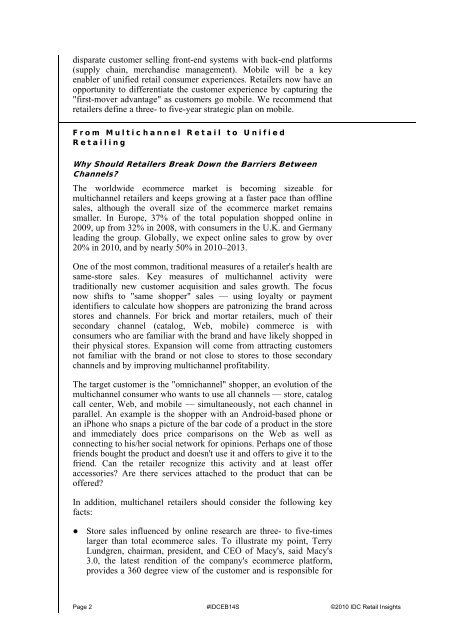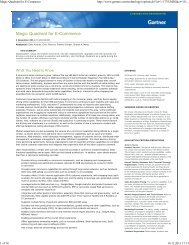Unified Retailing â Breaking Multichannel Barriers - Hybris
Unified Retailing â Breaking Multichannel Barriers - Hybris
Unified Retailing â Breaking Multichannel Barriers - Hybris
You also want an ePaper? Increase the reach of your titles
YUMPU automatically turns print PDFs into web optimized ePapers that Google loves.
disparate customer selling front-end systems with back-end platforms<br />
(supply chain, merchandise management). Mobile will be a key<br />
enabler of unified retail consumer experiences. Retailers now have an<br />
opportunity to differentiate the customer experience by capturing the<br />
"first-mover advantage" as customers go mobile. We recommend that<br />
retailers define a three- to five-year strategic plan on mobile.<br />
From <strong>Multichannel</strong> Retail to <strong>Unified</strong><br />
<strong>Retailing</strong><br />
Why Should Retailers Break Down the <strong>Barriers</strong> Between<br />
Channels?<br />
The worldwide ecommerce market is becoming sizeable for<br />
multichannel retailers and keeps growing at a faster pace than offline<br />
sales, although the overall size of the ecommerce market remains<br />
smaller. In Europe, 37% of the total population shopped online in<br />
2009, up from 32% in 2008, with consumers in the U.K. and Germany<br />
leading the group. Globally, we expect online sales to grow by over<br />
20% in 2010, and by nearly 50% in 2010–2013.<br />
One of the most common, traditional measures of a retailer's health are<br />
same-store sales. Key measures of multichannel activity were<br />
traditionally new customer acquisition and sales growth. The focus<br />
now shifts to "same shopper" sales — using loyalty or payment<br />
identifiers to calculate how shoppers are patronizing the brand across<br />
stores and channels. For brick and mortar retailers, much of their<br />
secondary channel (catalog, Web, mobile) commerce is with<br />
consumers who are familiar with the brand and have likely shopped in<br />
their physical stores. Expansion will come from attracting customers<br />
not familiar with the brand or not close to stores to those secondary<br />
channels and by improving multichannel profitability.<br />
The target customer is the "omnichannel" shopper, an evolution of the<br />
multichannel consumer who wants to use all channels — store, catalog<br />
call center, Web, and mobile — simultaneously, not each channel in<br />
parallel. An example is the shopper with an Android-based phone or<br />
an iPhone who snaps a picture of the bar code of a product in the store<br />
and immediately does price comparisons on the Web as well as<br />
connecting to his/her social network for opinions. Perhaps one of those<br />
friends bought the product and doesn't use it and offers to give it to the<br />
friend. Can the retailer recognize this activity and at least offer<br />
accessories? Are there services attached to the product that can be<br />
offered?<br />
In addition, multichanel retailers should consider the following key<br />
facts:<br />
● Store sales influenced by online research are three- to five-times<br />
larger than total ecommerce sales. To illustrate my point, Terry<br />
Lundgren, chairman, president, and CEO of Macy's, said Macy's<br />
3.0, the latest rendition of the company's ecommerce platform,<br />
provides a 360 degree view of the customer and is responsible for<br />
Page 2 #IDCEB14S ©2010 IDC Retail Insights





